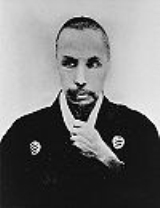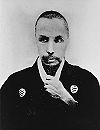
Sakuma Shozan
Encyclopedia

Politics of Japan
The politics of Japan is conducted in a framework of a parliamentary representative democratic monarchy, where Prime Minister of Japan is the head of government. Japanese politics uses a multi-party system. Executive power exercised by the government. Legislative power is vested in the Diet, with...
and scholar of the Edo era. He was the son of a samurai, and a native of Shinshu in today's Nagano-ken.
From the age of 23, he went to Edo
Edo
, also romanized as Yedo or Yeddo, is the former name of the Japanese capital Tokyo, and was the seat of power for the Tokugawa shogunate which ruled Japan from 1603 to 1868...
and for 10 years studied Chinese sciences .
He then started to study Western sciences (Rangaku
Rangaku
Rangaku is a body of knowledge developed by Japan through its contacts with the Dutch enclave of Dejima, which allowed Japan to keep abreast of Western technology and medicine in the period when the country was closed to foreigners, 1641–1853, because of the Tokugawa shogunate’s policy of national...
) at the age of 33, with the help of the Rangaku scholar Kurokawa Ryoan . He obtained in 1844 the "Huishoudelyk Woordboek", a Dutch translation of the encyclopedia written by the French Nöel Chomel. From the encyclopedia, he learnt how to make glass, and then magnets, thermometers, cameras and telescopes. The encyclopedia was later translated in Japanese by Utagawa Genshin under the title .
In 1849, he learned about electricity, through the book of the Dutch scientist Van den Bergh, and created Japan's first telegraph, 5 years before the gift of such a telegraph by Commodore Perry in 1854. He also invented electric machines derived from the Elekiter
Elekiter
The is the Japanese name for a type of generator of static electricity used for electric experiments in the 18th century. In Japan, Hiraga Gennai presented his own elekiter in 1776, derived from an elekiter from Holland...
.
From 1842, following an analysis of the defeat of China
China
Chinese civilization may refer to:* China for more general discussion of the country.* Chinese culture* Greater China, the transnational community of ethnic Chinese.* History of China* Sinosphere, the area historically affected by Chinese culture...
against Great Britain
Great Britain
Great Britain or Britain is an island situated to the northwest of Continental Europe. It is the ninth largest island in the world, and the largest European island, as well as the largest of the British Isles...
in the Opium War and the spread of Western influence in Asia, Sakuma Shozan actively proposed the introduction of Western military methods to the Bakufu and the establishment of maritime defense, through his book "Eight policies for the defense of the sea" . His writing brought some fame, and he became the teacher of several future leaders of modernization (Yoshida Shōin
Yoshida Shoin
Yoshida Shōin was one of the most distinguished intellectuals in the closing days of the Tokugawa shogunate...
, Katsu Kaishū
Katsu Kaishu
was a Japanese statesman, naval engineer during the Late Tokugawa shogunate and early Meiji period. Kaishū was a nickname which he took from a piece of calligraphy by Sakuma Shōzan. He went through a series of given names throughout his life; his childhood name was and his real name was...
, Sakamoto Ryōma
Sakamoto Ryoma
was a leader of the movement to overthrow the Tokugawa shogunate during the Bakumatsu period in Japan. Ryōma used the alias .- Early life :Ryōma was born in Kōchi, of Tosa han . By the Japanese calendar, this was the sixth year of Tenpō...
).
When Yoshida Shoin became convicted 1853 for trying to get secretly onboard one of Perry's ships to study foreign ways, Sakuma was also sentenced by association to house arrest , which he endured for 9 years. During the arrest, he continued to study Western sciences, and developed various electric machines based on the elekiter
Elekiter
The is the Japanese name for a type of generator of static electricity used for electric experiments in the 18th century. In Japan, Hiraga Gennai presented his own elekiter in 1776, derived from an elekiter from Holland...
and the Daniell battery, Japan's first seismic sensor, as well as improvements to guns.
After his liberation, Sakuma Shozan continued to advocate opening Japanese ports to foreign traders, as well as reinforcing the Bakufu through collaboration with the Imperial administration (Kōbu gattai
Kōbu Gattai
Kōbu gattai was a policy in Bakumatsu Japan aiming at obtaining a political coordination between the Bakufu and the Imperial Court....
).
Shōzan was assassinated by an assassin, or hitokiri named Kawakami Gensai
Kawakami Gensai
was a Japanese samurai of the late Edo period. A highly skilled swordsman, he was one of the four most notable assassins of the Bakumatsu period. Gensai's high-speed sword discipline was in the Shiranui-ryū.- Birth and Early Life :...
who felled Shozan with one strike in broad daylight.
Sakuma Shozan coined the still used phrase, "Japanese ethics, Western technology" as an illustration to the way Japan ought to handle modernization.
Shozan's son Miura Keinosuke was a member of the Shinsengumi
Shinsengumi
The were a special police force of the late shogunate period.-Historical background:After Japan opened up to the West following U.S. Commodore Matthew Perry's visits in 1853, its political situation gradually became more and more chaotic...
.

